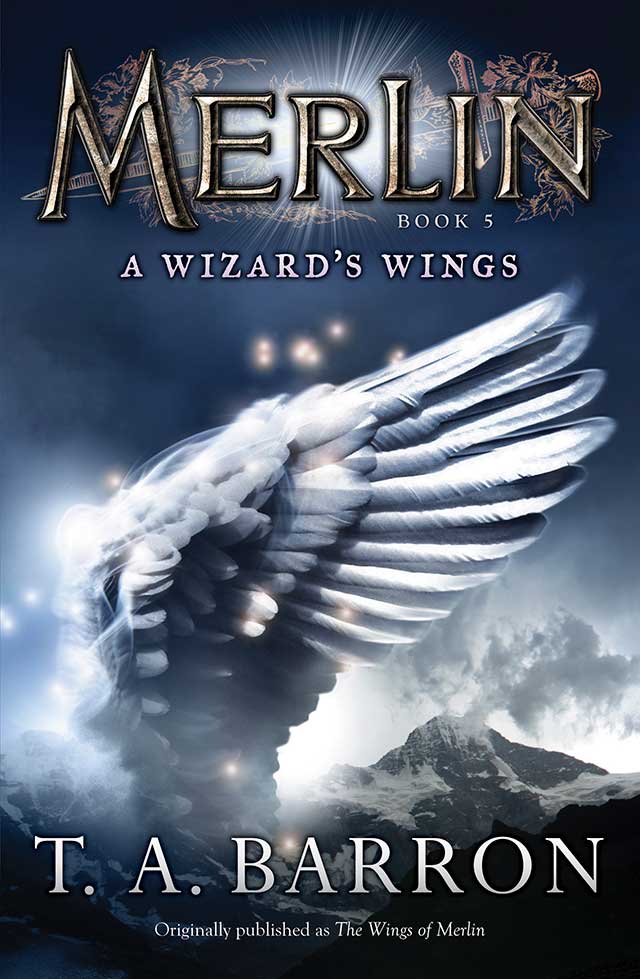The Remarkable Metaphor of Merlin
 Wizards are full of surprises. They change faces, personalities, and forms at will. They grow younger, older, or stay forever the same age. They appear when least expected, and often vanish when most needed.
Wizards are full of surprises. They change faces, personalities, and forms at will. They grow younger, older, or stay forever the same age. They appear when least expected, and often vanish when most needed.
In the sheer ability to surprise, however, one wizard outshines all the rest. He is the greatest of enchanters, the mentor of King Arthur, the inspiration of thousands of tales in dozens of languages. He is Merlin.
For nearly 15 centuries, Merlin has worked his unforgettable magic. Yet he remains as elusive—and as surprising—as ever. The traditional tales describe him variously as a prophet, a bard, a personification of the Celtic god Lleu, a magician, a madman, a trickster, a shaman, a priest, and a seer. Some hail him as the incarnation of divinity; others despise him as an Antichrist. From his first appearance in some of the earliest myths of Celtic Britain, some of them so ancient that their sources were already obscure when the great Welsh epics of the Mabinogian were first set down a thousand years ago, he evades predictable descriptions.
Time has made Merlin more famous—and more of a mystery. He counsels the young king in Malory’s Morte d’Arthur, builds Stonehenge in Robert de Baron’s twelfth-century Merlin, and spouts prophecies in Geoffrey of Monmouth’s Historia Regnum Brittainiae. In Spenser’s Faerie Queene and Ariosto’s Orlando Furioso, his roles and character traits further expand. Merlin is praised by the Norman historian Ordericus Vitalis, but is ridiculed by Shakespeare in King Lear and King Henry IV. The pamphleteer Jonathan Swift began the eighteenth century with “A Famous Prediction of Merlin, the British Wizard.” Tennyson explored his vulnerability in “Merlin and Vivien,” while Wordsworth described “the sage enchanter Merlin’s subtle schemes.” In this century, writers as diverse as T. H. White, Thomas Hardy, Marion Zimmer Bradley, C. S. Lewis, Mary Stewart, John Steinbeck, and Deepak Chopra have added new dimensions to Merlin’s character.
Yet despite the sagging shelves of books about this wizard, we seem no closer to knowing who he really is. Even if we throw in all the films, songs, poems, academic treatises, and other places he appears (now including the Internet)—he remains fundamentally mysterious. Merlin is as protean as he is pervasive.
So is there nothing consistent, nothing predictable, about Merlin’s character?
The answer, I believe, is that a surprising consistency exists. But this consistency lies not in his garb, his visions of the future, or his literary roles. It lies in Merlin’s unique embrace of history, psychology, myth, and spirituality. It takes the form of three fundamental themes: bonding with the natural world; finding universality; and embracing the dark as well as the light within ourselves. And in giving us these three themes, Merlin also gives us something more: a truly remarkable metaphor.
Nature as Inspiration
The most glowing threads in Merlin’s tapestry arise from his close connections with nature—which, in turn, arise from his Druid roots. His crystal cave, his invocation of sacred apple trees, his escape to the forest to lead the Wild Hunt of departed souls-all flow from Druid tradition. To Merlin, the language of a tree is not so distant from his own; the life of a wolf is replete with wisdom. And as a mythic figure, his deep connection with nature enhances our own. For, as W.B. Yeats once wrote, humanity has always yearned to connect with the cosmic order, “to reunite the perception of the spirit, of the divine, with natural beauty.”
Allow me to illustrate this point with a scene from The Lost Years of Merlin epic. Early in the first book, the boy who will one day become a wizard climbs a tree—first to escape from trouble, then purely for the thrill of it. As a sudden storm arises, whipping the tree and the boy clinging to its branches, he begins to feel less a creature of the land and more a creature of the wind itself. In time, he comes to realize that in nature’s awesome power of transformation lies the hope for his own.
The thrill rose in me again, driving me to climb. As the wind lifted, so did the elixir of scents from the trees. Resins from chafing branches on every side poured over me, immersing me in a river of aromas.
The first rumble of thunder came as I hauled myself up to the highest branch that could support my weight. With it came a rumble more powerful still, the collective calling of thousands of trees bending with the same wind. Rain began falling. Branches streamed like waterfalls of green. Tiny rivers cascaded down every trunk, twisting through moss meadows and bark canyons…. All the while, I rode out the gale.
When, at last, the storm subsided, the entire world seemed newly born. Sunbeams danced on rain-washed leaves. Curling columns of mist rose from every glade. The forest’s colors shone more vivid, its smells struck more fresh. And I understood, for the first time in my life, that the Earth was always being remade, that life was always being renewed. That it may have been the afternoon of this particular day, but it was still the very morning of Creation.
In the same vein, in The Seven Songs of Merlin, the second book of the epic, the young wizard becomes a fish—and, very nearly, a stone. In The Fires of Merlin, the third volume, he must learn the ways of a deer: to hear with his hooves, to run with the lightness of a breeze. And in the final two books, his connection with the natural world will deepen still more.
Universality
Some modern scholars believe that the richly woven tapestry myth surrounding Merlin sprang from a single historical thread, a Druid prophet who lived somewhere in what is now called Wales in the sixth century. But that is a matter for historians to debate. For whether or not Merlin was ever real in the realm of history, he is certainly real in other realms. Story. Imagination. Spirit. There he has long lived, and there he continues to thrive. He even (as many of us have discovered) accepts visitors on occasion.
Yet Merlin’s historical context cannot be ignored. For, along with a strong dose of legend and a touch of pure magic, it produced the original threads in his wondrous tapestry. Tattered and worn came those threads, and sometimes severed, for sixth-century Britain was a land in turmoil. Although it brimmed with diverse peoples, it was less a melting pot than a boiling cauldron of divisiveness and upheaval.
The Roman order lay in ruins, little more than a web of roads and names strewn across the land. Saxons, Angles, and Jutes continued to invade, warring with each other, with the Celts, and with the Picts and Scots, who had crossed Hadrian’s Wall to the north. Bubonic plague struck without warning, destroying entire villages. Mercenaries turned on their masters; alliances formed and evaporated overnight. Strange new languages echoed in the streets and fields. The Christians persecuted the Druids, and the reverse. Everybody persecuted the Jews.
Against this backdrop of chaos, the figure of Merlin stands in sharp contrast. The wizard is often depicted as a force for unity, a builder of bridges. Without Mage Merlin, as Malory recounts, the fellowship of the Table Round would never have been possible. Thanks to his unifying force, the Arthurian court includes:
fairy damsels met in forest wide,
knights of Logres, and of Lyonesse:
Lancelot, and Pelleas, and Pellinore…
Not only does Merlin employ the magical sign of the sword in the stone to bring these disparate factions together under Arthur, he also rises to defend the young king’s right to the throne. In the English poem Of Arthour and of Merlin, crafted in the thirteenth century, Merlin attacks some traitorous barons:
Merlin made enchantment
And cast great damage
Into the pavilions, wild fire
That burned bright as a candle clear.
Indeed, Merlin’s bridge building goes far beyond rival political factions. The same robed figure who arranges an alliance with the archbishop of Canterbury also does not hesitate (in Goeffrey of Monmouth’s Vita Merlini) to converse with an aged wolf as a friend. In the context of his time, it is truly remarkable that Merlin can both foresee (and, in some accounts inspire) Arthur’s quest for the Holy Grail, with its abundant Christian symbolism, and, at the same time, speak with the spirits of trees, rivers, and stones as an ancient Druid master.
This spirit of universality is a hallmark of Merlin. Perhaps that accounts, in part, for the revival of interest in the wizard and his lore at the close of the second millennium. In a world of divisiveness, when so many people seem bent on pulling us apart, Merlin represents someone who can bring us together, who can cross any boundaries.
That is why, in my own small additions to the tapestry of Merlin, I have chosen to depict his mother, Elen, as a woman who dares to combine old faiths with new ones, faraway cultures with those near at hand. She connects the tales of the Greeks to those of the Celts; she draws on the wisdom of Christians, Jews, and Druids alike. While she is shunned, even attacked, for her beliefs, she persists in building bridges whenever she can. Over the course of The Lost Years of Merlin epic (which comprises five volumes), Elen’s views affect the young Merlin profoundly. Through her, he begins to comprehend the connective tissue that touches us all.
Dark and Light
In the most ancient tales of Merlin, he possesses a devout, almost saintly mother, and a shadowy, demonic father. While his mother is present for at least a portion of his childhood, his father is hidden from view. Even when his tormented mother is accused of doing the work of the devil, his father does not rise to her defense. It is left to Merlin—in some tales, only one year old—to speak on her behalf.
Robert de Baron’s twelfth-century Merlin vividly describes his dual nature:
He held to whichever he wished, for he saw that he could render the devils their due and to Our Lord that which was his: for the devils only created his body, and Our Lord placed the spirit throughout his body.
Because of his darker side, Merlin can be derisive, menacing—and often tempted to make mischief. Just as often, however, his mischievous stance combines with his ability to perceive the underlying truth of a situation. In one tale, Merlin laughs at a man grieving at his child’s death, because he alone realizes that the priest conducting the funeral is the child’s true father. Such laughter, of course is tinged, with sorrow. He seems grimly aware of the bestiality of others—perhaps because he recognizes those qualities within himself.
Clearly, Merlin’s parentage is a metaphor for the light and dark sides of his own nature. Just as, in my own tales of the young Merlin, he must come to embrace both of his parents as part of himself, he must also make some deeper discoveries. For I believe that Merlin’s considerable wisdom about humanity came not from expelling or eliminating his dark side, but rather from embracing it, owning it as part of himself.
 I will go one step further. Ultimately, it was Merlin’s sense of human frailty, alongside human possibility, that equipped him to play his central role in the story of Camelot. For to serve as the mentor of King Arthur, he needed to understand the underlying weaknesses of the Round Table as well as its high ideals. He needed to appreciate its tragic fate as well as its lasting impact.
I will go one step further. Ultimately, it was Merlin’s sense of human frailty, alongside human possibility, that equipped him to play his central role in the story of Camelot. For to serve as the mentor of King Arthur, he needed to understand the underlying weaknesses of the Round Table as well as its high ideals. He needed to appreciate its tragic fate as well as its lasting impact.
For this reason, throughout The Lost Years of Merlin epic, I explore the links between the young wizard’s greatest insights and his greatest flaws. For example, in Book One, he unleashes his emerging powers in a violent rage—and succeeds in blinding himself, searing his own soul no less than his eyes. Yet only through his blindness does he come, eventually, to see the world in an entirely different way: not through his eyes, but through his heart.
As the setting for my novels about Merlin’s lost youth, I chose the legendary, mist-shrouded isle of Fincayra. Celtic lore describes it as “an island beneath the waves.” What better location for a young wizard to discover the hidden reaches of his own self? The dark side as well as the light?
On top of that, Fincayra is known in ancient lore as a halfway point between this world and the other world, a bridge between earth and heaven. An omphalos, the Greek might say. But the island’s best description came from Elen, Merlin’s mother, who called simply an “in between place.” Like the mist swirling about its shores, which is neither quite water nor quite air, Fincayra is neither quite mortal nor quite immortal. It is something in between.
Merlin, too, is something in between. He is not wholly light, yet not wholly dark. He is not truly a man, yet not truly a god. He is not really old, yet not really young. Carl Jung would have found him a compelling character, for Merlin’s mythic powers sprang both from the unconscious and from the conscious, just as his wisdom flowed both from nature and from culture.
The Metaphor of Merlin
Ever a master of surprise, Merlin gave me a surprise six years ago. In researching an earlier novel, The Merlin Effect, in which the wizard unexpectedly appears in the twentieth century, I had immersed myself in the traditional lore. To my puzzlement, I found a significant gap in the legends—a gaping hole, as it were, in the tapestry.
Merlin’s youth, that crucial, formative time when he would have discovered his own origins as well as his mysterious powers, was only fleetingly mentioned in the traditional lore. While a few tales spoke of his strange parentage and precocious infancy, he then vanished from sight—until, as an older youth, he reappeared to explain the secret of the fighting dragons to the treacherous King Vortigern. In between lay a gap of several years.
What were the young Merlin’s most cherished dreams? His most powerful passions? His most haunting fears? Those first sorrows, those youthful joys, those initial brushes with wisdom—all this and more remained unexplored.
I began to wonder whether, as some supposed, he had wandered alone in the woods during those years lost from time. Or whether he had really disappeared from more than the world of story and song. Perhaps, just perhaps…he had disappeared from the very world itself.
So began the tale of Merlin’s lost years. A boy, almost drowned, finds himself washed ashore on the rugged coast of Wales. The sea has robbed him of everything but his torn tunic. He lies on the rock, tormented by the shadows of things he cannot recall. For he has no memory. No home. And no name.
If I close my eyes, and breathe to the rolling rhythm of the sea, I can still remember that long ago day. Harsh, cold, and lifeless it was, as empty of promise as my lungs were empty of air.
Since that day, I have seen many others, more than I have the strength left to count. Yet that day glows as bright as the Galator itself, as bright as the day I found my own name, or the day I first cradled a baby who bore the name Arthur.
Perhaps I remember it so clearly because the pain, like a scar on my soul, will not disappear. Or because it marked the ending of so much. Or, perhaps, because it marked a beginning as well as an ending: the beginning of my lost years.
Then came another surprise. I realized that Merlin’s lost youth itself constituted a metaphor. For that bedraggled boy was completely unaware that he would, one day, become the greatest wizard of all time. No doubt he would have dismissed the very notion as absurd. Yet by the end of the epic, he will indeed comprehend his destiny. Having gained much, and having lost still more, he will be ready at last to assume his celebrated role in Arthurian legend.
The more I learn about Merlin, like so many things in life, the less I really know. Yet I continue to be struck by the power of his metaphor. Like the boy who washed ashore with no clue whatsoever about his wondrous future, each of us harbors hidden capacities, hidden possibilities. Though they may be yet undiscovered, they are nonetheless there.
Perhaps we also harbor a bit of magic, as well. Perhaps we might even find a wizard, a Merlin of our own, somewhere inside of ourselves.
And what a remarkable surprise that would be.

